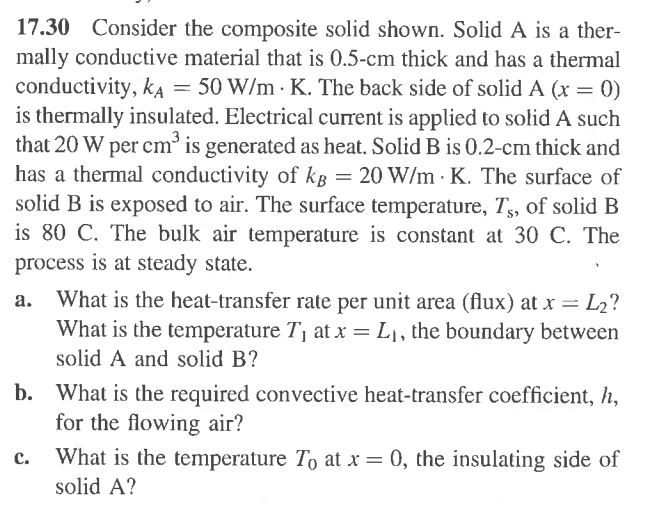17.30 Consider the composite solid shown. Solid A is a ther- mally conductive material that is 0.5-cm thick and has a thermal conductivity, KA = 50 W/m K. The back side of solid A (x = 0) is thermally insulated. Electrical current is applied to solid A such that 20 W per cm³ is generated as heat. Solid B is 0.2-cm thick and has a thermal conductivity of kg = 20 W/m K. The surface of solid B is exposed to air. The surface temperature, Ts, of solid B is 80 C. The bulk air temperature is constant at 30 C. The process is at steady state. a. What is the heat-transfer rate per unit area (flux) at x = L₂? What is the temperature T₁ at x = L₁, the boundary between solid A and solid B? b. What is the required convective heat-transfer coefficient, h, for the flowing air? C. What is the temperature To at x = 0, the insulating side of solid A?
17.30 Consider the composite solid shown. Solid A is a ther- mally conductive material that is 0.5-cm thick and has a thermal conductivity, KA = 50 W/m K. The back side of solid A (x = 0) is thermally insulated. Electrical current is applied to solid A such that 20 W per cm³ is generated as heat. Solid B is 0.2-cm thick and has a thermal conductivity of kg = 20 W/m K. The surface of solid B is exposed to air. The surface temperature, Ts, of solid B is 80 C. The bulk air temperature is constant at 30 C. The process is at steady state. a. What is the heat-transfer rate per unit area (flux) at x = L₂? What is the temperature T₁ at x = L₁, the boundary between solid A and solid B? b. What is the required convective heat-transfer coefficient, h, for the flowing air? C. What is the temperature To at x = 0, the insulating side of solid A?
Introduction to Chemical Engineering Thermodynamics
8th Edition
ISBN:9781259696527
Author:J.M. Smith Termodinamica en ingenieria quimica, Hendrick C Van Ness, Michael Abbott, Mark Swihart
Publisher:J.M. Smith Termodinamica en ingenieria quimica, Hendrick C Van Ness, Michael Abbott, Mark Swihart
Chapter1: Introduction
Section: Chapter Questions
Problem 1.1P
Related questions
Question

Transcribed Image Text:17.30 Consider the composite solid shown. Solid A is a ther-
mally conductive material that is 0.5-cm thick and has a thermal
conductivity, KA = 50 W/m K. The back side of solid A (x = 0)
is thermally insulated. Electrical current is applied to solid A such
that 20 W per cm³ is generated as heat. Solid B is 0.2-cm thick and
has a thermal conductivity of kg = 20 W/m K. The surface of
solid B is exposed to air. The surface temperature, Ts, of solid B
is 80 C. The bulk air temperature is constant at 30 C. The
process is at steady state.
a. What is the heat-transfer rate per unit area (flux) at x = L₂?
What is the temperature T₁ at x = L₁, the boundary between
solid A and solid B?
b. What is the required convective heat-transfer coefficient, h,
for the flowing air?
C. What is the temperature To at x = 0, the insulating side of
solid A?
Expert Solution
This question has been solved!
Explore an expertly crafted, step-by-step solution for a thorough understanding of key concepts.
Step by step
Solved in 2 steps with 4 images

Recommended textbooks for you

Introduction to Chemical Engineering Thermodynami…
Chemical Engineering
ISBN:
9781259696527
Author:
J.M. Smith Termodinamica en ingenieria quimica, Hendrick C Van Ness, Michael Abbott, Mark Swihart
Publisher:
McGraw-Hill Education

Elementary Principles of Chemical Processes, Bind…
Chemical Engineering
ISBN:
9781118431221
Author:
Richard M. Felder, Ronald W. Rousseau, Lisa G. Bullard
Publisher:
WILEY

Elements of Chemical Reaction Engineering (5th Ed…
Chemical Engineering
ISBN:
9780133887518
Author:
H. Scott Fogler
Publisher:
Prentice Hall

Introduction to Chemical Engineering Thermodynami…
Chemical Engineering
ISBN:
9781259696527
Author:
J.M. Smith Termodinamica en ingenieria quimica, Hendrick C Van Ness, Michael Abbott, Mark Swihart
Publisher:
McGraw-Hill Education

Elementary Principles of Chemical Processes, Bind…
Chemical Engineering
ISBN:
9781118431221
Author:
Richard M. Felder, Ronald W. Rousseau, Lisa G. Bullard
Publisher:
WILEY

Elements of Chemical Reaction Engineering (5th Ed…
Chemical Engineering
ISBN:
9780133887518
Author:
H. Scott Fogler
Publisher:
Prentice Hall


Industrial Plastics: Theory and Applications
Chemical Engineering
ISBN:
9781285061238
Author:
Lokensgard, Erik
Publisher:
Delmar Cengage Learning

Unit Operations of Chemical Engineering
Chemical Engineering
ISBN:
9780072848236
Author:
Warren McCabe, Julian C. Smith, Peter Harriott
Publisher:
McGraw-Hill Companies, The